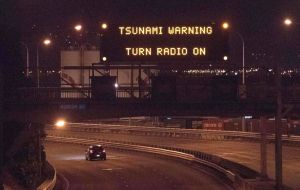MercoPress. South Atlantic News Agency
Hundreds of aftershocks follow major earthquake and tsunami in New Zealand; thousands flee to high ground
 “It was the most significant shock I can remember in Wellington,” Prime Minister John Key told reporters at a dawn news conference
“It was the most significant shock I can remember in Wellington,” Prime Minister John Key told reporters at a dawn news conference  New Zealand's Geonet measured Monday's first quake at magnitude 7.5, while the U.S. Geological Survey put it at 7.8.
New Zealand's Geonet measured Monday's first quake at magnitude 7.5, while the U.S. Geological Survey put it at 7.8.  Power lines and telecommunications are down, sizeable cracks in roads and damage to infrastructure can be seen after the original quake just after midnight
Power lines and telecommunications are down, sizeable cracks in roads and damage to infrastructure can be seen after the original quake just after midnight A strong new earthquake with a magnitude of 6.2 rattled New Zealand's South Island on Monday, hours after a more powerful quake killed at least two people, damaged roads and buildings and sent thousands fleeing to higher ground. Emergency response teams were already flying by helicopter to the region at the epicenter of the original 7.8 magnitude quake, which struck just after midnight some 91 km northeast of Christchurch in the South Island, amid reports of injuries and collapsed buildings.
New Zealand's capital Wellington was a virtual ghost town with workers ordered to stay away while the local council assessed the risk to buildings. Severe weather with 140kph gale-force winds was forecast for the area, which could cause more damage, such as from glass loosened by the tremors.
The new tremor, a 6.2 quake recorded at about 1.45 p.m. local time, was the most powerful of hundreds of aftershocks in the South Pacific country. It rattled frayed nerves in an area where memories of a deadly 2011 quake are still fresh.
Christchurch, the largest city on New Zealand's ruggedly beautiful South Island, is still recovering from the 2011 quake, which measured 6.3 magnitude and killed 185 people.
Power lines and telecommunications are down, and daylight revealed sizeable cracks in roads and damage to infrastructure after the original quake just after midnight shook New Zealanders from their beds.
“It was the most significant shock I can remember in Wellington,” Prime Minister John Key told reporters at a dawn news conference from the parliament's underground bunker in the capital city. “There will be quite major costs around roads and infrastructure.”
New Zealand's Geonet measured Monday's first quake at magnitude 7.5, while the U.S. Geological Survey put it at 7.8. The quakes and aftershocks rattled buildings as far away as the New Zealand capital, Wellington, 300 km to the northeast.
Key said he hoped to travel to the tourist town of Kaikoura, about 150 km northeast of Christchurch and which appeared to have borne the brunt of the quake.
New Zealand's Civil Defense declared a state of emergency for the Kaikoura region soon after Monday's large aftershock.
A tsunami warning that led to mass evacuations after the original quake was downgraded after large swells hit Wellington, in the North Island, and Christchurch. There were no new tsunami warnings issued after the 6.2 aftershock.
New Zealand lies in the seismically active “Ring of Fire”, a 40,000 km arc of volcanoes and oceanic trenches that partly encircles the Pacific Ocean. Around 90 percent of the world's earthquakes occur within this region.




Top Comments
Disclaimer & comment rules-

Read all commentsI hope the government sends any help that is needed.
Nov 14th, 2016 - 07:56 pm 0Commenting for this story is now closed.
If you have a Facebook account, become a fan and comment on our Facebook Page!